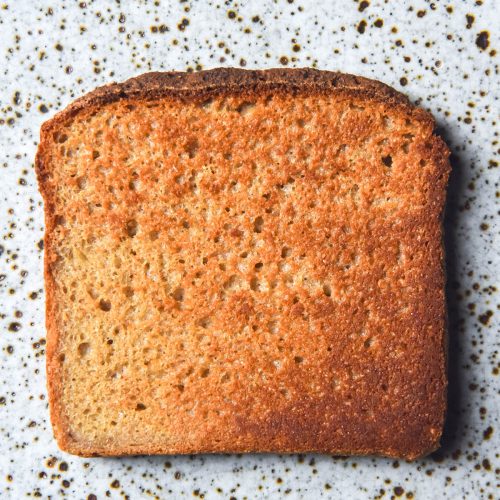
Quinoa bread (gluten free)
Gluten free, egg free, vegan, xanthan gum free*This recipe uses Australian tablespoons. Use ml for international accuracy. 20ml = 4 US, Canadian, UK and European teaspoons
Equipment
- size small USA Pan Pullman loaf pan - 23cm length X 10cm width X 10cm height or 9 X 4 X 4 inches.
Ingredients
- 400 g quinoa flour (see notes)
- 100 g light buckwheat flour
- 100 g tapioca flour
- 25 g psyllium husk powder
- 7.5 g instant yeast
- 20 ml (1 tablespoon)* oil of choice
- 20 ml (1 tablespoon)* maple syrup
- 10-12 g salt
- 645-745 g water
Instructions
- Grease and line your size small USA Pan Pullman loaf pan - 23cm length X 10cm width X 10cm height or 9 X 4 X 4 inches.
- Whisk together the dry ingredients and then whisk in the wet. The dough will be liquid to begin with, but will quickly firm up as you whisk.
- The ideal consistency for this bread dough immediately after proofing is just wet enough to lose a bit of shape. If you hold your whisk up, the batter should fall back into the bowl in thick ribbons. The dough shouldn't be liquid like other batters; more of a thick pancake batter or nut butter consistency. If your dough is thicker than this, add more water to adjust.
- Cover the bowl of dough and proof in a warm spot for 1 hour.
- After the dough has proofed, it should be subtly taller in the bowl. When you stir the dough, it should look and feel light and airy inside as you stir.
- Place the dough into the greased Pullman pan and use wet hands to smooth the top of the dough down to a flat top.
- Cover the bread with a snug cover that doesn’t touch the dough itself – I use an inverted produce bag.
- Proof for 1-2 hours (up to 3 in winter or a cold kitchen) or until the loaf reaches the lip or domes lightly over the sides of the Pullman pan.
- While you are waiting, preheat your oven to 220C/430F.
- Once the dough has fully proofed, place it in the oven for 30 minutes.
- After 30 minutes, turn the oven down to 200C/400F and cook for an additional 20-30 minutes.
- The loaf should be golden brown and might have sunk back to have a flat top that is the height of the Pullman pan (this is normal for this loaf).
- Remove from the oven and leave to cool in the tin for about 10-15 minutes. After this time, gently remove the bread from the tin and place it on a wire rack to cool completely. Don’t slice the loaf until it is completely cool.
- Leftovers keep well sliced and in an airtight container in the fridge or freezer.
Notes
- I generally find that store bought quinoa flour either goes rancid very quickly or is already rancid. I process whole quinoa grains in my NutriBullet to make my own quinoa flour. I process the grains through one cycle, open the lid for a few minutes to let out any heat, then process again. All up it takes about 5-10 minutes (including the time taken to let the flour cool off).
- See the body of the post if you want to rinse your quinoa prior to making flour.
- I have not tested any substitutes for any flours.
- See the body of the post for tips on making your best loaf.
Tried this recipe?Let us know how it was!